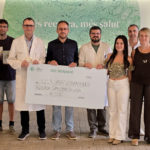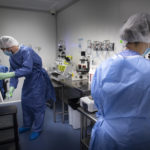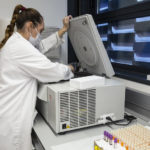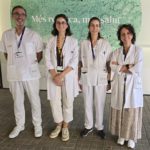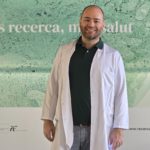
An international team of researchers has demonstrated that the tetravalent dengue vaccine Qdenga provides significant protection against the disease under real-world conditions during the major 2024 epidemic in São Paulo, Brazil. The study, published in the journal The Lancet Infectious Diseases and led by Dr. Otavio Ranzani, head of the DataHealth Lab group at the Sant Pau Research Institute (IR Sant Pau). Together with Dr. Julio Croda, Fiocruz, Brazil, provides the first evidence of the vaccine’s effectiveness following its approval.
Dengue is one of the fastest-growing mosquito-borne viral diseases worldwide, driven by climate change and the spread of the Aedes mosquito. Each year it causes millions of infections in tropical and subtropical regions, and more outbreaks are being detected in non-endemic areas, such as Europe. In this context, having effective vaccines with solid real-world effectiveness data is an urgent public health need.
A Groundbreaking Study Conducted Amid an Epidemic
The study was carried out in the state of São Paulo, the epicenter of the 2024 dengue epidemic, which recorded tens of thousands of cases. Health authorities decided to prioritize vaccination in adolescents aged 10 to 14, since in endemic areas this age group accounts for a large proportion of symptomatic cases and faces a considerable risk of hospitalization. This age range is also consistent with the current WHO vaccination recommendation. In addition, this group is highly exposed to the mosquito vector due to their daily activities and mobility, which increases the likelihood of infection. In this context, an immunization campaign was launched that, over the course of the year, administered nearly 690,000 doses of Qdenga.
The research team analyzed more than 90,000 adolescents who presented with acute fever and underwent specific laboratory tests (NS1 antigen detection or PCR). Using a design known as test-negative case-control, they compared the proportion of vaccinated individuals among those who tested positive for dengue and those who tested negative, allowing estimation of the real-world effectiveness of the vaccine under everyday conditions.
Results showed that after a single dose, the vaccine reduced symptomatic dengue cases by around 50% with the first dose and by 62% with the second, and hospitalizations by 68%. Protection began 14 days after the first dose, was maintained during the first three months, and then declined, reinforcing the importance of completing the recommended and approved two-dose schedule for longer-lasting protection.
“This study design allowed us to quickly and accurately evaluate the vaccine’s effectiveness amid an epidemic, using real patient data from the healthcare system. It is a powerful approach to generate evidence in health emergencies,” explained Dr. Ranzani.
A Robust Study, Though With Some Limitations
The study has several strengths that reinforce the validity of its results. It is the first evaluation of the Qdenga vaccine under real-world conditions, beyond clinical trials, and was conducted in an exceptional context: a major dengue epidemic in São Paulo. The large number of adolescents included in the analysis enabled robust estimates of effectiveness, while the use of a test-negative case-control design reduced the risk of biases related to healthcare-seeking behavior. In addition, results remained consistent across different analytical methods, providing greater confidence in the conclusions.
However, the authors also noted some limitations that should be considered. Vaccine coverage achieved was relatively low, which limited the study’s power to analyze effectiveness after the second dose in detail. Information on prior dengue immunity among adolescents was also unavailable. Finally, serotype circulation during the outbreak was concentrated on DENV-1 and DENV-2, preventing evaluation of effectiveness against all four virus serotypes (DENV-1, DENV-2, DENV-3, and DENV-4).
“Although the study has some limitations, the findings consistently show that Qdenga protects against dengue and reduces the risk of hospitalization. These data will be critical in guiding countries’ vaccination decisions,” emphasized Dr. Ranzani.
International and European Relevance
Until now, evidence on the vaccine was based solely on controlled phase 3 clinical trials. This new study is the first to demonstrate its impact on the general population under real-world conditions, in the midst of a major epidemic, reinforcing its value for public health decision-making.
Although Europe is not an endemic region, the spread of the Aedes mosquito linked to climate change has favored the emergence of local dengue outbreaks in countries such as France and Italy, while imported cases among travelers continue to rise. Catalonia is an example of this trend: between 2022 and 2024, more than 500 imported dengue cases were reported, mainly in people who had traveled to endemic regions. However, episodes of local transmission have already been detected, with two cases in 2018–2019, one in 2022, and an outbreak in 2024.
“Although in Catalonia and Europe most cases are still imported, the risk of local transmission is increasing. Having effective vaccines like Qdenga can make a difference in responding to future outbreaks and protecting travelers,” said Dr. Ranzani.
Public Health Implications
The results of this study are highly practical. On one hand, they support the use of Qdenga in emergency campaigns in endemic countries, where dengue outbreaks can quickly overwhelm health systems and cause a high number of hospitalizations. Evidence indicates that a single dose already provides significant protection within a few weeks, making the vaccine a key tool to curb ongoing epidemics and reduce hospital burden.
On the other hand, the data are also relevant for non-endemic countries, where most cases are imported but the risk of local transmission is increasing. In this context, the vaccine may play an essential role in traveler prophylaxis and in the prevention of autochthonous outbreaks, strengthening health system preparedness against the spread of the Aedes mosquito.
“The message is clear: the vaccine works and can protect against both mild and severe dengue. But to ensure sustained protection, we must complete the vaccination schedule. Our results can help policymakers and regulatory agencies better plan vaccination strategies,” added Dr. Ranzani.
The study was funded by the Conselho Nacional de Desenvolvimento Científico e Tecnológico (CNPq) in Brazil and involved an international group of researchers, including collaborators from the United States, in partnership with the São Paulo State Health Department.
A New Research Group at IR Sant Pau
This study is part of the first investigations of the DataHealth Lab, a newly established group at IR Sant Pau under the direction of Dr. Otavio Ranzani. Its creation responds to the need for teams capable of generating scientific evidence that is not only methodologically rigorous but also has a tangible impact on population health and public policy.
The DataHealth Lab is built on three main pillars: Epidemiology, Data Science, and Implementation Science. From this multidisciplinary perspective, the group addresses some of the most pressing challenges in global health. These include the effects of climate change and exposure to environmental pollutants on health, the growing threat of respiratory and emerging infections, the impact of antimicrobial resistance on health systems, and the improvement of critical care. Another key focus is the evaluation of the real-world effectiveness of vaccines, a line of work directly connected to the newly published study on the dengue vaccine.
The lab is also committed to innovation in critical care, exploring new strategies such as adaptive clinical trials, the use of telemedicine to improve care under high-pressure conditions, and the integration of artificial intelligence tools to support clinical decision-making. All this is pursued with a vision of open, inclusive, and sustainable science, oriented toward generating knowledge useful to society and health systems.
With the creation of the DataHealth Lab, IR Sant Pau strengthens its leadership in biomedical research and consolidates its role as a benchmark in the use of advanced data to tackle major public health challenges nationally and internationally.
Article Reference:
Ranzani OT, Lazar Neto F, Mareto LK, Brumatti TS, de Oliveira RD, da Silva PV, dos Santos ER, D’Agostini TL, De Paula RAC, Dean NE, Ko AI, Cummings DAT, Andrews JR, Hitchings MDT, Croda J. Effectiveness of the TAK-003 dengue vaccine in adolescents during the 2024 outbreak in São Paulo, Brazil: a test-negative, case–control study. *Lancet Infect Dis* 2025. https://doi.org/10.1016/s1473-3099(25)00382-2





